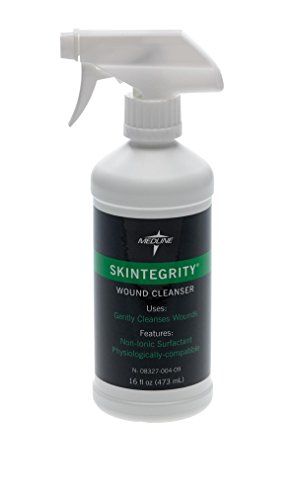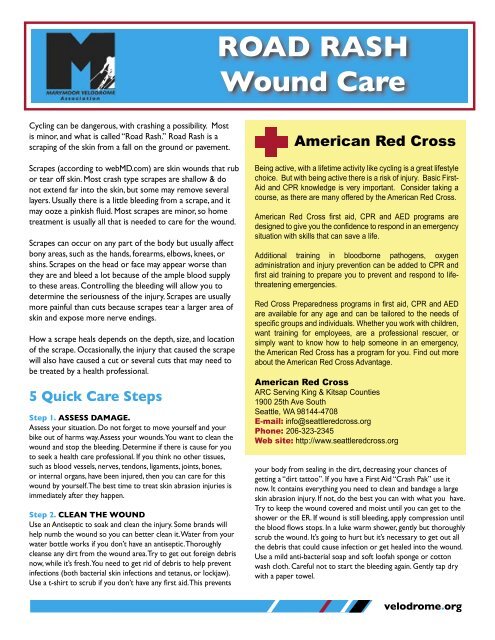

If you did not seek medical attention and your wound becomes infected, you should head to a doctor as soon a possible. Infections can spread and cause significant health problems, so take them seriously. Signs of an infection include swelling, pus, a foul stench, and fever. No matter what degree of road rash you have, you may contract an infection around the wound site. However, you should still go to the hospital. The skin’s nerves have been stripped away in some cases, and you may not feel any pain. These wounds extend through the dermis, and extensive bleeding and broken bones are likely. So you may also get pain medication to help with the discomfort.Ī third-degree road rash could likely lead to a hospital stay. Unfortunately, the doctor will need to explore the wound to clean and extract all the dirt and debris.
Road rash wound care skin#
In the case of the second degree, a doctor will go through the same general treatment model as a first degree but prescribe a more powerful ointment to help your skin heal. You’ll likely know immediately that you need to go to the hospital for second- or third-degree road rash.

See also Why Should You Hire a DUI Lawyer? Second-, Third-Degree Treatment This cuts down the risk of infection and keeps the skin moist so it can heal. You’ll want to change the dressing daily and apply more ointment or petroleum jelly. Then, treat the road rash with an antibiotic salve and apply a dressing. If necessary, you may have to get in there with a pair of tweezers. Your aim here is to remove as much of the dirt and debris from the crash as possible. First, wash your hands thoroughly before attempting to treat the wound. First-Degree TreatmentĪ first-degree case of road rash may not mean a trip to the hospital. This type of road rash almost always produces some level of permanent scarring. The wound is most certainly bleeding and runs a high risk of infection. This may include return visits for further cleaning and dealing with potential infections.Ī third-degree case is the worst kind, with the abrasion exposing muscle, bone, and tendons. As a result, you’ll have dirt and debris lodged in the wound, and you’ll need medical attention to clean and treat it.Ī second-degree case has the potential for permanent scarring, so make sure you follow your doctor’s treatment regimen. Second-degree cases mean that your skin has been broken, although not all the way through to the fat or muscle. You may need to seek medical attention to clean and care for the wound right after it happens, but you should be able to further treat the injury at home. If you suffer from a first-degree case of road rash, your skin will be red, have scrapes, maybe bleed a bit, and have light bruising. Rated by DegreeĪll road rash is painful, but medical professionals have categorized the extent of the injury by degrees. This may mean stitches and, worst case, skin grafts. With an open wound, you’ll require outside means to close the injury. Along with the avulsion, expect broken bones and muscle damage from a compression injury. Generally, that something else is your bike.

Layers of muscle, fat, and in the worst cases, bone, are exposed during avulsion.Ĭompression means your body has been caught between the ground and something else to cause the road rash.
Road rash wound care professional#
See also Advantages of Hiring a Professional Bailing Service OnlineĪn avulsion is when the skin has been scraped and is the most common type of road rash. The three types are avulsion, compression, and an open wound. You can contract multiple types of road rash in one crash, depending on how the injury unfolds. The face is usually not impacted unless the rider drives their motorcycle without a helmet. The areas of the body impacted by road rash are usually the palm, knees, lower legs, shoulder, hips, and outer thighs. In general, the extent of the road rash is determined by your speed, the road surface, and how much protective gear you’re wearing. However, when it’s scraped off, not only is this sensationally painful, but it also exposes you to dirt, grime, tar, and anything your body sweeps up as it skids along the road. Your skin is the largest organ of your body, and it protects you from the elements, microbes, and bacteria. In the case of road rash, you’re one surface moving at speed and the road is another. Your body is then exposed to friction, or “the resistance that one surface encounters when moving over another.” When your body comes off your motorcycle with momentum, it eventually makes contact with the road or the ground.


 0 kommentar(er)
0 kommentar(er)
